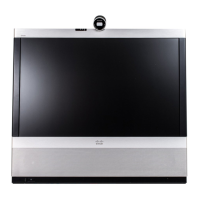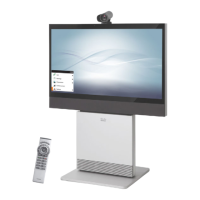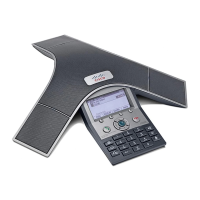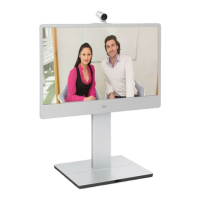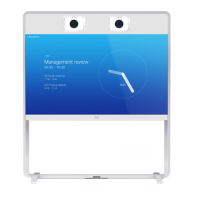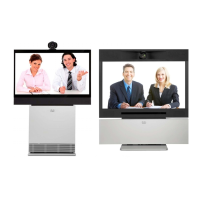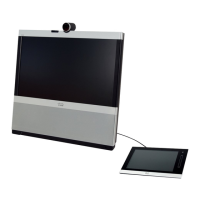




Do you have a question about the Cisco EX60 and is the answer not in the manual?
| Product Type | Video conferencing endpoint |
|---|---|
| Resolution | 1920 x 1080 |
| Microphone | Integrated microphone array |
| Speaker | Integrated speakers |
| Protocols | SIP, H.323 |
| Connectivity | Ethernet, Wi-Fi |
| Video Standards | H.264 |
| Audio Standards | G.711, G.722 |
| Power Supply | AC adapter |
Guidelines for successful video conferences, covering general etiquette and meeting room setup.
Steps to initiate a call using entries from your contact list for efficient communication.
How to modify contact details before initiating a call to ensure successful connection.
Instructions on dialing a contact by entering their name via the virtual keyboard.
Steps to initiate a call by directly entering the IP address of the recipient.
Guidance on making calls by dialing a phone number using the numerical dialpad.
How to answer, decline, or ignore incoming calls on the video conferencing system.
Managing incoming calls when already engaged in a conference or call.
Procedure for transferring an ongoing call to another participant.
How to conduct a consultative transfer by speaking to the recipient before transferring.
Steps to end your participation in a call or conference without affecting others.
How to place a call on hold and later resume it.
Managing calls on shared lines in a call center environment, including barge-in.
Adjusting the bandwidth allocated to a call to improve quality or manage consumption.
Setting the system to not respond to incoming calls while allowing outgoing calls.
Putting the system into standby mode to save energy while remaining available for calls.
Accessing the keypad during an active call for entering extensions or PIN codes.
Steps to add new participants to an ongoing conference call.
Methods for accepting and merging an incoming call into a current conference.
Displaying a list of all participants in a conference, their status, and speaking roles.
Customizing the screen layout during presentations to optimize viewing experience.
Fixing a specific participant as the prominent speaker, overriding voice switching.
Removing a participant from a conference call.
Instructions for initiating and ending content sharing from your PC.
Using the camera as a document camera to share physical items.
Adjusting how content and presenters are displayed during a presentation.
Accessing and viewing a list of upcoming scheduled meetings.
Procedures for joining scheduled meetings and managing meeting reminders.
Understanding and choosing meetings when multiple are scheduled simultaneously.
Accessing and searching the corporate directory for contact information.
Viewing and managing the list of recent calls, including removing entries.
Managing your personalized list of frequently called contacts.
Adding contacts to your Favorites list directly from an active call.
Adjusting camera zoom, whitebalance, exposure, and backlight settings.
Controlling the selfview image, including turning it on/off and resizing.
Changing the size of the Picture-in-Picture selfview window.
Relocating the selfview window on the screen for better viewing.
Adjusting the pan, zoom, and tilt of the remote participant's camera.
Instructions for connecting the EX60 model to power, network, and other devices.
Instructions for connecting the EX90 model to power, network, and other devices.
Navigating to the system settings menu via the touch screen interface.
Customizing the background image displayed on the touch pad and screen.
Configuring ringtone volume, selecting ringtones, and enabling/disabling keytones.
Connecting Bluetooth headsets to the video system.
Adjusting camera whitebalance, exposure, and backlight compensation.
Configuring DVI mode and color settings for the display.
Choosing the language for the touch interface menu.
Viewing system hardware, software, network, SIP, and H.323 status.
Information on call rate, encryption, and audio/video parameters during a call.
Enabling additional system logging for troubleshooting purposes.
Performing an orderly restart of the video system.
Accessing administrative settings that may be password protected.
Configuring date, time formats, time zone, and NTP settings.
Configuring auto-answer, call rate, and default protocol settings.
Using the wizard to get your system online and follow on-screen instructions.
Configuring MultiWay and MultiSite modes for video conferencing.
Specifying IPv4/IPv6 usage and static IP or DHCP settings.
Viewing detailed network status information for the codec.
Viewing network status information for the touch controller.
Configuring SIP settings, including URI, transport, proxy, and login.
Configuring H.323 settings, including number, ID, and gatekeeper.
Enabling EMC resilience to prevent false signals from electromagnetic noise.
Resetting the system to factory defaults, losing configurations and local contacts.


